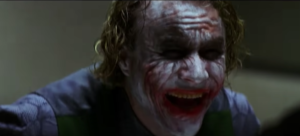Mary Douglas considers a joke’s role in destroying “hierarchy and order” and “denigrating and devaluing” dominant values or codes. By this definition a joke becomes an “antirite.” While rites impose order, a joke “disorganises” and departs from order. The Joker’s (as played by Heath Ledger in The Dark Knight Rises and Joaquin Phoenix in Joker) maniacal fits of laughter in Joker breaks the narrative and flow of the scene, going against standard accepted behaviour. The suggestion of an implicit joke is absent, but the laughter in this case, becomes the joke. Even though the Joker is said to have a medical condition that is the reason for his uncontrollable laughter this example illumines the Freudian notion of release.


As Douglas argues, “laughter itself is cathartic,” and leads to a surfacing of repressed desires. The joker’s laughter mirrors his subconscious self, something that a joke brings to the surface, according to Freud. In this sense, laughter is equivalent to the joke and there need not be an audience that understands the joke for laughter to provide a gateway into the subconscious or unconscious. Upon hearing such laughter, the audience’s desire to produce sense from nonsense is provoked, in a manner similar to a joke. The absence and inability to understand the joke, may make it fail, yet laughter becomes a joke given its ability to produce nonsense and depart from conventional norms.
Laughter as a reaction to an absent joke, becomes sinister. In these scenes, the laughter is unexpected, uncontrollable and devilish. Even though there is no joke per se or much laughter from the audience , such intense laughter does provoke the audience to think about the character’s idiosyncratic behaviors. In a sense, using the joker to represent people with mental illnesses also highlights how distanced normal people are from those with such illnesses. Just like a joke’s workability may be influenced by “social perception,” the Joker’s laughter in this case can only be understood by others like him.
I think your notion that laughter without a joke makes it sinister is quite interesting, since we usually expect laughter to be a result of something funny and understandable to us. However, laughter is often used in horror films not to lighten the mood, but on the contrary, makes the audience more tense. The same, I believe, can be said about smiling. Pennywise’s smile in IT is supposed to make him appear friendly and innocent to lure children into his traps. However, we, as viewers, know that there is something frightening behind that smile, since we are judging not only by the words Pennywise is saying or by his expression, but also by the overall context and tone of the scene.
This is a fascinating breakdown of this concept. It’s interesting, because villains are often portrayed as having an “evil laugh,” which is made to signify mania since what they’re laughing about it often world dominance, which make the laughter creepy and unfunny. The Joker just does it better.
The connection here between cathartic laughter with a character like The Joker who is known for his laugh and smile that stem from mental disturbance, is rather interesting to me. I wonder if this translates the same to the many different portrayals of The Joker in films. While I know it is the same character, I believe different films bring out different elements of his personality. So perhaps his laugh in the 2019 rendition of his character is different to that of The Joker in the 2017 Lego Batman film.